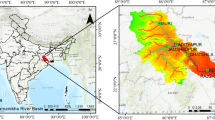Abstract
The data of two soil and vegetation surveys of flood basins of the Mamai irrigation system performed in 1987 and 2012 are compared. This irrigation system is found within the Caspian Lowland in Western Kazakhstan oblast of Kazakhstan. The thickness of the humus horizon decreased by 4 cm on the average attesting to the first-second stages of soil degradation. The humus content in the A + B1 horizons decreased by 0.3% on the average with variations corresponding to the first-third degradation stages. From 1987 to 2012, the area of saline soils and the content of exchangeable sodium in them also increased attesting to the development of desertification in the studied zone. The flooded portion of flood basins decreased from 84% in 1987 to 69% in 2012, and the groundwater level rose from 3.6–4.0 to 1.8–3.1 m. Soil degradation processes, together with adverse anthropogenic impacts, resulted in a decrease in the projective cover of valuable plant species and the productivity of herbs grown in flood basins.
Similar content being viewed by others
References
I. P. Aidarov, Regulation of the Water-Salt and Nutrient Regimes in Irrigated Soils (Agropromizdat, Moscow, 2005) [in Russian].
I. M. Gabbasova, R. R. Suleimanov, R. N. Sitdikov, T. T. Garipov, A. V. Komissarov, “The effect of long-term irrigation on the properties of leached chernozems in the forest-steppe of the southern Cis-Ural Region,” Eur. Soil Sci. 39(3), 283–289 (2006).
E. A. Gurbanov, “Soil degradation due to erosion under furrow irrigation,” Eur. Soil Sci. 43(12), 1387–1393 (2010).
V. S. Dmitriev, Flood Irrigation (Kolos, Moscow, 2004) [in Russian].
Dospekhov, B.A., Methods of Field Experimentation (Agropromizdat, Moscow, 1985) [in Russian].
A. N. Kashtanov, “Scientific Problems of Modern Farming,” Vestn. RASKhN, No. 2, 21–24 (1996).
B. A. Keller, “Water freshening in the northern part of the Caspian Lowland and the southern bounary of irrigation,” in presnenie na severnoi okraine Kaspiiskoi nizmennosti i yuzhnaya granitsa orosheniya, in Proceedings of the Commission on Irrigation, Iss. 1 (Izd. AN SSSR, Leningrad, 1933), pp. 13–23 [in Russian].
B. M. Kogut, “Assessment of the humus content in arable soils of Russia,” Eur. Soil Sci. 45(9), 843–851 (2012).
B. M. Kogut, “Principles and methods of assessing the content of labile organic matter in plowed soils,” Eur. Soil Sci. 36(3), 283–290 (2003).
V. A. Korolev, “Changes in the main physical properties of ordinary chernozems under the impact of irrigation,” Eur. Soil Sci. 41(10), 1092–1097 (2008).
A Handbook on the Design and Drilling of Water Wells (Nedra, Moscow, 1983) [in Russian].
I. P. Kruzhilin, Flood Irrigation: Current State, Problems, and Solutions (Volgograd, 2000) [in Russian].
R. M. Kurmangaliev, “Environmental problems related to transboundary flow of the Ural River and the ways of their solution,” Mater. Intern. Conf. The Ural River Basin: Ecology, Heritage, and Transboundary Cooperation between Russian and Kazakhstan Ural’sk, 2008), pp. 50–55 [in Russian].
P. S. Lozovitskii, “Monitoring of the humus status of soils of the Ingulets irrigation system,” Eur. Soil Sci. 45(3), 290–302 (2012).
B. N. Nasiev, “A study of degradation of flood basins in western Kazakhstan,” Issledov. Rezul’taty, 53(1), 93–97 (2012).
M. K. Onaev, “Improvement of the efficiency of flood irrigation in West Kazakhstan oblast,” Mekhaniz. Elektrifik. Sel’sk. Khozyaistva, No. 2, 18–20 (2008).
A. A. Rode, “Soils of the Dzhanybek Station: Morphology, Particle-Size Distribution, and Physical Properties,” Tr. Pochven. Inst. im. V.V. Dokuchaeva 56, 3–214 (1961).
V. A. Rozhkov, M. Nurberdiev, and A. Rangavar, “Agroecological bases for raising the productivity of degraded soils in Khorasan province of Iran,” Eur. Soil Sci. 40(12), 1335–1342 (2007).
A. M. Rusanov and L. V. Anilova, “The humus formation and humus in forest-steppe and steppe chernozems of the southern Cisural region,” Eur. Soil Sci. 42(10), 1101–1108 (2009).
Systematic List of Soils of Plain Territories and Their Diagnostic Characteristics (Alma-Ata, 1981) [in Russian].
I. I. Sudnitsyn, “Soil monitoring and the sustainable development of Russia,” Eur. Soil Sci. 43(8), 950–951 (2010).
B. I. Tuktarov, Flood Irrigation (Izd. SGAU, Saratov, 2005) [in Russian].
B. A. Yagodin, Practicum on Agricultural Chemistry (VO “Agropromizdat”, Moscow, 1987) [in Russian].
A. D. Baez-Gonzalez, “Using satellite and field data with crop growth modeling to monitor and estimate corn yield in Mexico,” Crop Sci. 42, 1943–1949 (2002).
S. J. Nield, J. L. Boettinger, and R. D. Ramsey, “Digitally mapping of gypsic and natric soils using Landsat and topographic data,” Soil Sci. Soc. Am. J. 71(1), 245–252.
Z. Shi and G. R. Ruecker, “Modeling of cotton yields in the Amu Darya River floodplains of Uzbekistan integrating multitemporal remote sensing and minimum field data,” Agron. J. 99, 1317–1326.
U. Sultangazin, “Northern Kazakhstan agriculture monitoring by Terra/MODIS,” Proc. if the 31 ISRSE (St. Petersburg, 2005).
Author information
Authors and Affiliations
Corresponding author
Additional information
Original Russian Text © B.N. Nasiev, R. Eleshev, 2014, published in Pochvovedenie, 2014, No. 6, pp. 750–758.
Rights and permissions
About this article
Cite this article
Nasiev, B.N., Eleshev, R. Modern state of the soils of flood irrigation systems in the semidesert zone. Eurasian Soil Sc. 47, 613–620 (2014). https://doi.org/10.1134/S1064229314060076
Received:
Published:
Issue Date:
DOI: https://doi.org/10.1134/S1064229314060076



